High Efficiency Uranium(VI) Removal from Wastewater by Strong Alkaline Ion Exchange Fiber: Effect and Characteristic
Abstract
1. Introduction
2. Material and Methods
2.1. Materials and Reagents
2.2. Characterization Techniques
2.3. Methods
2.3.1. Preparation of SAIEF
2.3.2. Static Adsorption Experiments
2.3.3. Dynamic Adsorption Experiments
2.4. Calculation
3. Results and Discussion
3.1. Characterization of SAIEF
3.1.1. SEM/EDS Analysis of SAIEF
3.1.2. FTIR Analysis
3.2. U(VI) Adsorption Properties
3.2.1. Effect of pH
3.2.2. Effect of Contact Time and Adsorption Kinetics
3.2.3. Effect of Initial U(VI) Concentration and Adsorption Isotherm
3.2.4. Effect of the Fiber Dosage
3.3. Gradient Descent Experiments with Constant Solid-to-Liquid Ratio
3.4. Dynamic Adsorption
3.4.1. Saturated Adsorption Capacity Determination
3.4.2. Two-Grade Serial Dynamic Adsorption Experiment
3.5. Repeatability
4. Conclusions
Author Contributions
Funding
Institutional Review Board Statement
Data Availability Statement
Conflicts of Interest
References
- Li, J.; Wang, X.; Zhao, G.; Chen, C.; Chai, Z.; Alsaedi, A.; Hayatf, T.; Wang, X. Metal-organic framework-based materials: Superior adsorbents for the capture of toxic and radioactive metal ions. Chem. Soc. Rev. 2018, 47, 2322–2356. [Google Scholar] [CrossRef]
- Uggla, Y. Risk and safety analysis in longterm perspective. Futures 2004, 36, 549–564. [Google Scholar] [CrossRef]
- Hogan, A.C.; VanDam, R.A.; Markich, S.; Camilleri, C. Chronic toxicity of Uranium to a tropical green alga (Chlorellasp.) in natural waters and the influence of dissolved organic carbon. Aquat. Toxicol. 2005, 75, 343–353. [Google Scholar] [CrossRef]
- Vigier, J.-F.; Laplace, A.; Renard, C.; Miguirditchian, M.; Abraham, F. Uranium (III)-Plutonium (III) co-precipitation in molten chloride. J. Nucl. Mater. 2018, 499, 394–400. [Google Scholar] [CrossRef]
- Zhou, Q.; Tan, K.; Zeng, S.; Liu, D. Synergetic treatment of Urannium-Bearing Wstewater with Sulfate Reducing Bcteria and Zero-Valent Iron. At. Energy Sci. Technol. 2009, 43, 808–812. [Google Scholar]
- Crane, R.A.; Dickinson, M.; Popescu, I.C.; Scott, T.B. Magnetite and zero-valent iron nanoparticles for the remediation of uranium contaminated environmental water. Water Res. 2011, 45, 2931–2942. [Google Scholar] [CrossRef] [PubMed]
- Noubactep, C.; Schoner, A.; Meinrath, G. Mechanism of Uranium removal from the aqueous solution by elemental iron. J. Hazard. Mater. 2006, 132, 202–212. [Google Scholar] [CrossRef]
- Ding, C.C.; Cheng, W.C.; Nie, X.Q.; Yi, F.C. Synergistic mechanism of U(VI) sequestration by magnetite-graphene oxide composites: Evidence from spectroscopic and theoretical calculation. Chem. Eng. J. 2017, 324, 113–121. [Google Scholar] [CrossRef]
- Mar Camacho, L.; Deng, S.; Parra, R.R. Uranium removal from groundwater by natural clinoptilolite zeolite: Effects of pH and initial feed concentration. J. Hazard. Mater. 2010, 175, 393–398. [Google Scholar] [CrossRef]
- Wu, L.; Lin, X.; Zhou, X.; Luo, X. Removal of uranium and fluorine from wastewater by double-functional microsphere adsorbent of SA/CMC loaded with calcium and aluminum. Appl. Surf. Sci. 2016, 384, 466–479. [Google Scholar] [CrossRef]
- Kumar, S.; Loganathan, V.A.; Gupta, R.B.; Barnett, M.O. An Assessment of U (VI) removal from groundwater using biochar produced from hydrothermal carbonization. J. Environ. Manag. 2011, 92, 2504–2512. [Google Scholar] [CrossRef]
- Wang, G.; Liu, J.; Wang, X.; Xie, Z.; Deng, N. Adsorption of Uranium (VI) from aqueous solution onto cross-linked chitosan. J. Hazard. Mater. 2009, 168, 1053–1058. [Google Scholar] [CrossRef]
- Bai, J.; Yao, H.; Fan, F.; Lin, M.; Zhang, L.; Ding, H.; Lei, F.; Wu, X.; Li, X.; Guo, J.; et al. Biosorption of Uranium by chemically modified Rhodotorula glutinis. J. Environ. Radioact. 2010, 101, 969–973. [Google Scholar] [CrossRef]
- Liang, P.-l.; Yuan, L.-y.; Deng, H.; Wang, X.-c.; Wang, L.; Li, Z.-j.; Luo, S.-z.; Shi, W.-q. Photocatalytic reduction of uranium(VI) by magnetic ZnFe2O4. Appl. Catal., B. 2020, 267, 118688. [Google Scholar] [CrossRef]
- Theerthagiri, J.; Lee, S.J.; Karuppasamy, K.; Arulmani, S.; Veeralakshmi, S.; Ashokkumar, M.; Choi, M.Y. Application of advanced materials in sonophotocatalytic processes for the remediation of environmental pollutants. J. Hazard. Mater. 2021, 412, 125245. [Google Scholar] [CrossRef] [PubMed]
- Malovanyy, A.; Plaza, E.; Trela, J.; Malovanyy, M. Combination of ion exchange and partial nitritation/Anammox process for ammonium removal from mainstream municipal wastewater. Water Sci. Technol. 2014, 70, 144–151. [Google Scholar] [CrossRef]
- Wang, P.; Lv, C.-X.; Sheng, Q.; Sun, H.-T.; Zhang, L. Research development of uranium-containing wastewater treatment technologies. Xiandai Huagong/Mod. Chem. Ind. 2016, 36, 23–27. [Google Scholar]
- Chen, T.; Zhang, J.; Ge, H.; Li, M.; Li, Y.; Liu, B.; Duan, T.; He, R.; Zhu, W. Efficient extraction of uranium in organics-containing wastewater over g-C 3 N 4 /GO hybrid nanosheets with type-II band structure. J. Hazard. Mater. 2020, 384, 121383. [Google Scholar] [CrossRef]
- Atia, B.M.; Sakr, A.K.; Gado, M.A.; El-Gendy, H.S.; Abdelazeem, N.M.; El-Sheikh, E.M.; Hanfi, M.Y.; Sayyed, M.I.; Al-Otaibi, J.S.; Cheira, M.F. Synthesis of a New Chelating Iminophosphorane Derivative (Phosphazene) for U(VI) Recovery. Polymers 2022, 14, 1687. [Google Scholar] [CrossRef] [PubMed]
- Koid, Y.; Uchino, M.; Yamada, K. Studies of collectors. ix. the flotation of a trace amount of uranium by using 2-(alkylamino)propionohydroxamic acid and cotelomer-type surfactants bearing hydroxyaminocarbonyl and pyridyl groups. Bull. Chem. Soc. Jpn. 2006, 60, 3477–3483. [Google Scholar] [CrossRef]
- Yarlagadda, S.; Gude, V.G.; Camacho, L.M.; Pinappu, S.; Deng, S. Potable water recovery from As, U, and F contaminated ground waters by direct contact membrane distillation process. J. Hazard. Mater. 2011, 192, 1388–1394. [Google Scholar] [CrossRef] [PubMed]
- Molinari, R.; Argurio, P.; Poerio, T. Membrane Processes Based on Complexation Reactions of Pollutants as Sustainable Wastewater Treatments. Sustainability 2009, 1, 978–993. [Google Scholar] [CrossRef]
- Guruprashanth, N.; Hegde, R.; Suresh, B. A Review on Organic Adsorbents for the Removal of Toxic Metals from Waste Water. Asian J. Adv. Res. Rep. 2021, 15, 75–85. [Google Scholar] [CrossRef]
- Sakr, A.K.; Al-Hamarneh, I.F.; Gomaa, H.; Abdel Aal, M.M.; Hanfi, M.Y.; Sayyed, M.I.; Khandaler, M.U.; Cheira, M.F. Removal of uranium from nuclear effluent using regenerated bleaching earth steeped in β-naphthol. Radiat. Phys. Chem. 2022, 200, 110204. [Google Scholar] [CrossRef]
- Li, L.; Li, H.; Lin, M.; Wen, J.; Hu, S. Effects of chain conformation on uranium adsorption performance of amidoxime adsorbents. Sep. Purif. Technol. 2023, 307, 122777. [Google Scholar] [CrossRef]
- Huang, G.; Li, W.; Liu, Q.; Liu, J.; Zhang, H.; Li, R.; Li, Z.; Jing, X.; Wang, J. Effecient removal of uranium(VI) from simulated seawater with hyperbranchedpolyethylenimine(HPEI)—functionalized polyacrylonitrile fibers. New J. Chem. 2018, 42, 168–176. [Google Scholar] [CrossRef]
- Yin, L.; Hu, B.; Zhuang, L.; Fu, D.; Li, J.; Hayat, T.; Alsaedi, A.; Wang, X. Synthesis of flexible cross-linked cryptomelane-type manganese oxide nanowire membranes and their application for U(VI) and Eu(III) elimination from solutions. Chem. Eng. J. 2020, 381, 122744. [Google Scholar] [CrossRef]
- Xia, X.; Dong, F.; Nie, X.; Pan, N.; Liu, C.; Ding, C.; Wang, J.; Cheng, W.; He, H.; Sun, S.; et al. Efficient adsorption of U(VI) using in low-level radioactive wastewater containing organic matter by amino groups modified polyacrylonitrile fibers. J. Radioanal. Nucl. Chem. 2022, 331, 921–936. [Google Scholar] [CrossRef]
- Nie, X.; Zhang, Y.; Jiang, Y.; Pan, N.; Liu, C.; Wang, J.; Ma, C.; Xia, X.; Liu, M.; Zhang, H.; et al. Efficient extraction of u(vi) from uranium enrichment process wastewater by amine-aminophosphonate-modified polyacrylonitrile fibers. Sci. Total Environ. 2022, 831, 154743. [Google Scholar] [CrossRef]
- Zhou, C.; Li, M.; Zeng, Q. Study on adsorption of heavy mental by ion exchange fiber. Tech. Equip. Environ. Pollut. Control 2003, 4, 26–28. [Google Scholar]
- Zeng, H.; Yu, W. Study on adsorption behavior of heavy metal ions by new cation exchange fibers. Technol. Water Treat. 1987, 1, 1–9. [Google Scholar] [CrossRef]
- Zheng, X.; Ye, L.; Jiang, J.; Wu, X.; Wu, W. Determination of lead and cadmium in regenerated zinc by inductively coupled plasma atomic emission spectrometry after extraction separation with strongly basic anion exchange fiber. Met. Anal. 2019, 39, 76–84. [Google Scholar]
- Mihrin, D.; Andersen, J.; Jakobsen, P.W.; Larsen, R.W. Highly localized H2O librational motion as a far-infrared spectroscopic probe for microsolvation of organic molecules. Phys. Chem. Chem. Phys. 2019, 21, 1717–1723. [Google Scholar] [CrossRef]
- Jiang, Y.H.; Sun, C.L.; Li, Z.L.; Cao, A.Y.; Li, Z.W. Enhanced stimulated Raman scattering of weak-gain mode C-H stretching vibration of benzene. Acta Phys. Sin. (Overseas Ed.) 2011, 60, 6. [Google Scholar]
- Zhao, D.; Wang, Z.; Lu, S.; Shi, X. An amidoxime-functionalized polypropylene fiber: Competitive removal of Cu(II), Pb(II) and Zn(II) from wastewater and subsequent sequestration in cement mortar. J. Clean. Prod. 2020, 274, 123049. [Google Scholar] [CrossRef]
- Li, Y.; Simon, A.O.; Jiao, C.; Zhang, M.; Yan, W.; Rao, H.; Liu, J.; Zhang, J. Rapid removal of Sr2+, Cs+ and UO22+ from solution with surfactant and amino acid modified zeolite Y. Microporous Mesoporous Mater. 2020, 274, 123049. [Google Scholar] [CrossRef]
- Ahmed, W.; Nunez-Delgado, A.; Mehmood, S.; Ali, S.; Qaswar, M.; Shakoor, A.; Chen, D. Highly efficient uranium (VI) capture from aqueous solution by means of a hydroxyapatite-biochar nanocomposite: Adsorption behavior and mechanism. Environ. Res. 2021, 201, 111518. [Google Scholar] [CrossRef] [PubMed]
- Su, S.; Chen, R.; Liu, Q.; Liu, J.; Zhang, H.; Li, R.; Zhang, M.; Liu, P.; Wang, J. High efficiency extraction of U(VI) from seawater by incorporation of polyethyleneimine, polyacrylic acid hydrogel and luffa cylindrical fibers. Chem. Eng. J. 2018, 345, 526–535. [Google Scholar] [CrossRef]
- Zhang, J.; Luo, X. Bioaccumulation characteristics and acute toxicity of uranium in Hydrodictyon reticulatum: An algae with potential for wastewater remediation. Chemosphere 2021, 289, 133189. [Google Scholar] [CrossRef] [PubMed]
- El-Shahawi, M.; El-Sonbati, M. Retention profile, kinetics and sequential determination of selenium(IV) and (VI) employing 4,4′-dichlorodithizone immobilizedpolyurethane foams. Talanta 2005, 67, 806–815. [Google Scholar] [CrossRef]
- Kavitha, D.; Namasivayam, C. Experimental and kinetic studies on methylene blue adsorption by coir pith carbon. Bioresour. Technol. 2007, 98, 14–21. [Google Scholar] [CrossRef]
- Zhu, K.; Gao, Y.; Tan, X.; Chen, C. Polyaniline-modified Mg/Al layered double hydroxide composites and their application in efficient removal of Cr(VI). ACS Sustain. Chem. Eng. 2016, 4, 4361–4369. [Google Scholar] [CrossRef]
- Chen, Z.; Chen, W.; Jia, D.; Liu, Y.; Zhang, A.; Wen, T.; Liu, J.; Ai, Y.; Song, W.; Wang, X. N, P, and S codoped graphene-Like carbon nanosheets for ultrafast uranium(VI) capture with high capacity. Adv. Sci. 2018, 5, 1800235. [Google Scholar] [CrossRef] [PubMed]
- Deng, S.; Wang, P.; Zhang, G.; Dou, Y. Polyacrylonitrile-based fiber modified with thiosemicarbazide by microwave irradiation and its adsorption behavior for Cd(II) and Pb(II). J. Hazard. Mater. 2016, 307, 64–72. [Google Scholar] [CrossRef] [PubMed]
- Kumar, P.A.; Ray, M.; Chakraborty, S. Adsorption behaviour of trivalent chromium on amine-based polymer aniline formaldehyde condensate. Chem. Eng. J. 2009, 149, 340–347. [Google Scholar] [CrossRef]
- Liu, X.; Li, J.; Wang, X.; Chen, C.; Wang, X. High performance of phosphatefunctionalized graphene oxide for the selective adsorption of U(VI) from acidic solution. J. Nucl. Mater. 2015, 466, 56–64. [Google Scholar] [CrossRef]
- Guo, Y.; Huang, T.; Wen, G.; Cao, X. The simultaneous removal of ammonium and manganese from groundwater by iron-manganese co-oxide filter film: The role of chemical catalytic oxidation for ammonium removal. Chem. Eng. J. 2017, 308, 322–329. [Google Scholar] [CrossRef]
- Wang, F.; Liao, Y.; Xia, L. Poly(amidoamine) dendrimer decorated dendritic fibrousnano-silica for efficient removal of uranium (VI). J. Solid State Chem. 2021, 303, 122511–122521. [Google Scholar] [CrossRef]
- Cheng, Y.; He, P.; Dong, F.; Nie, X.; Ding, C.; Wang, S.; Zhang, Y.; Liu, H.; Zhou, S. Polyamine and amidoxime groups modified bifunctional polyacrylonitrile-based ion exchange fibers for highly efficient extraction of U(VI) from real uranium mine water. Chem. Eng. J. 2019, 367, 198–207. [Google Scholar] [CrossRef]
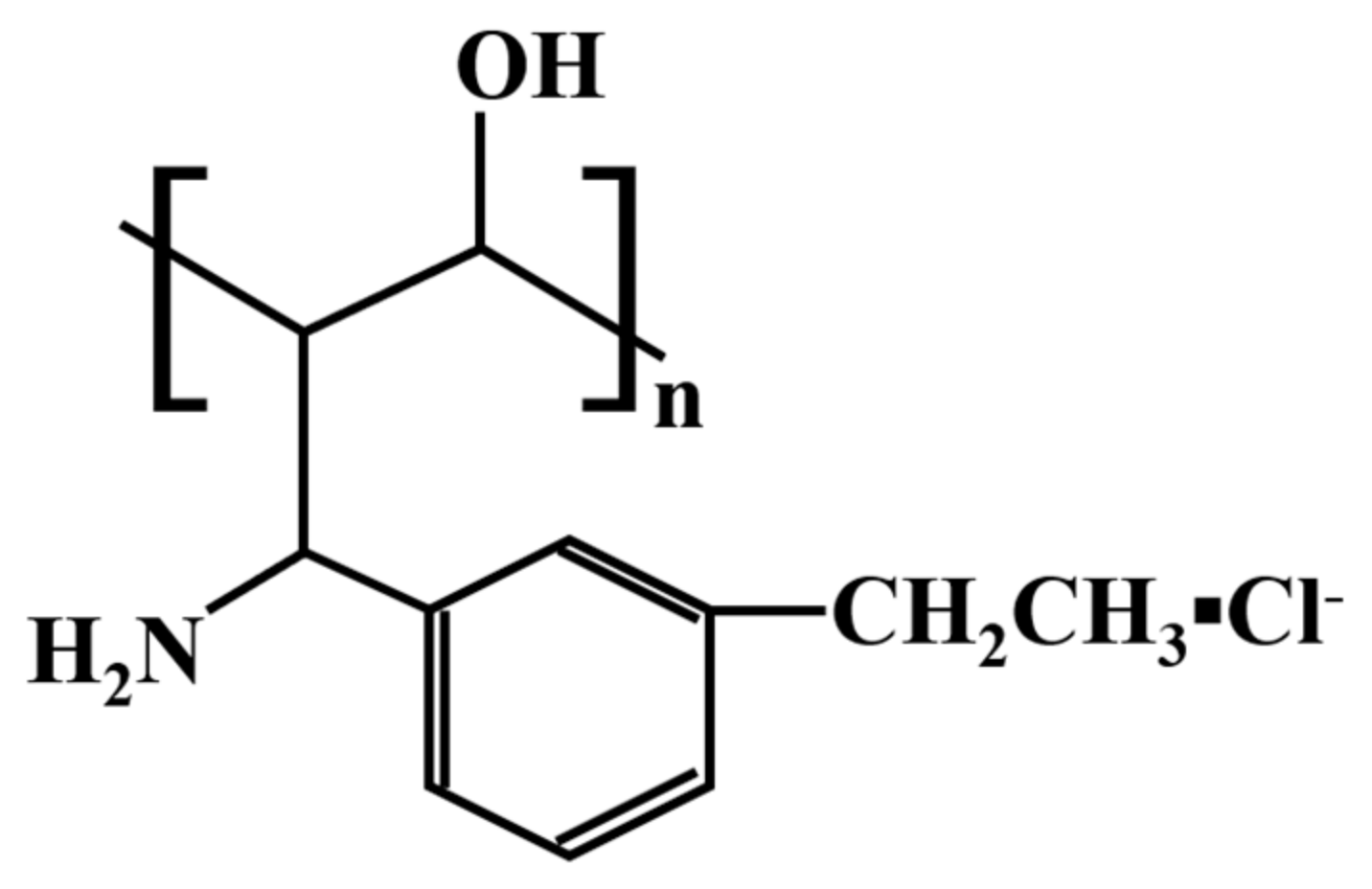
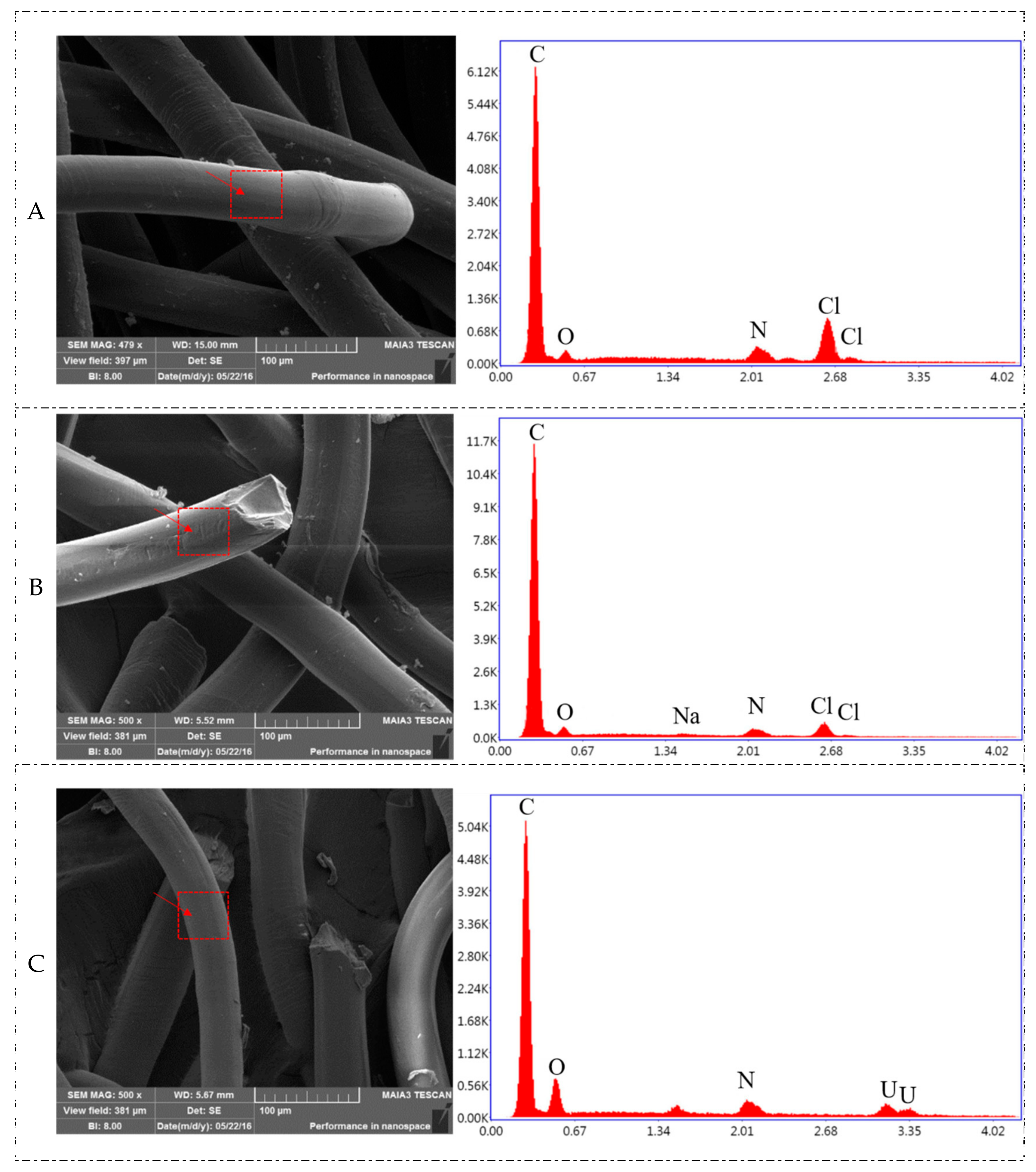
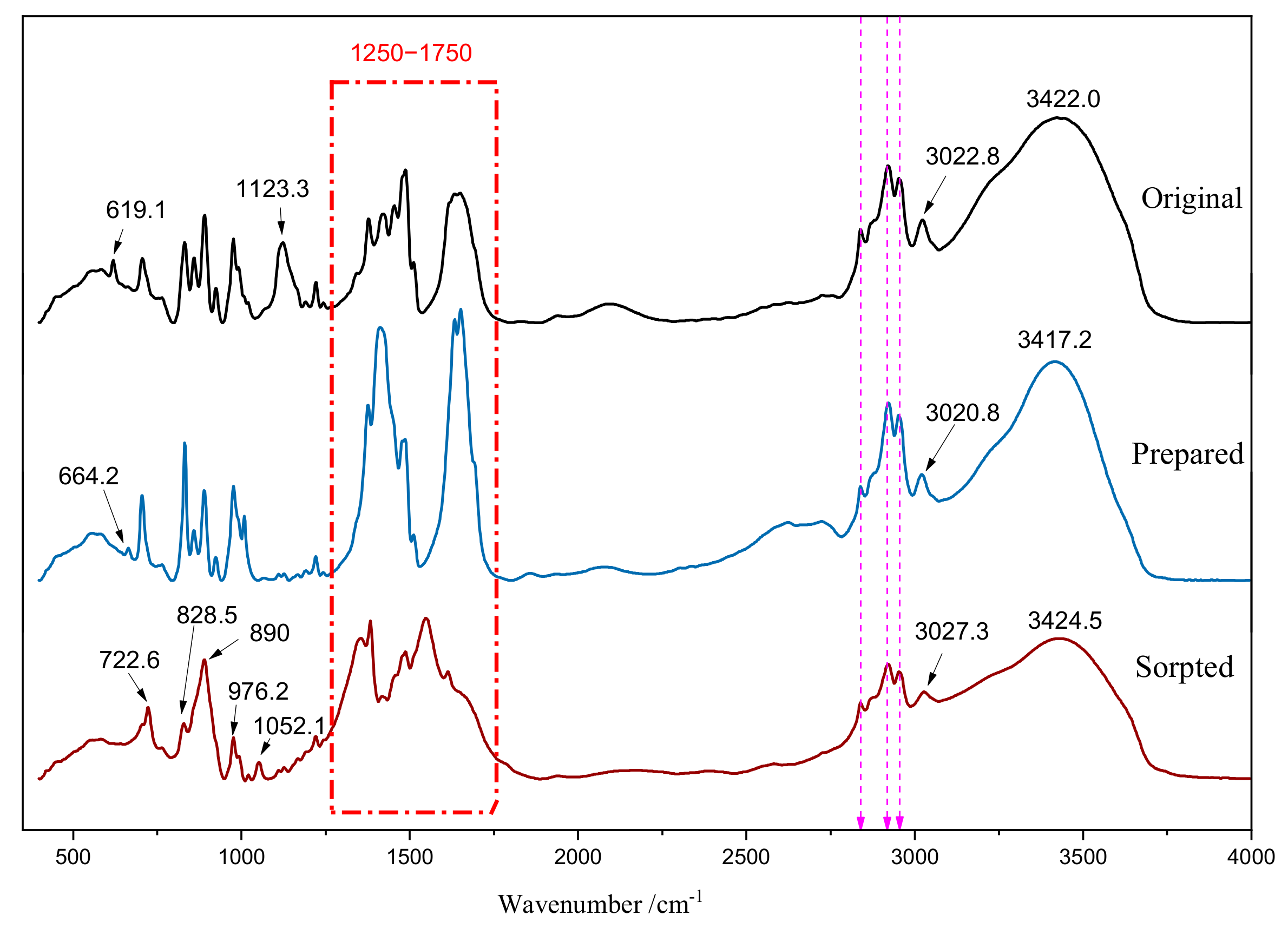
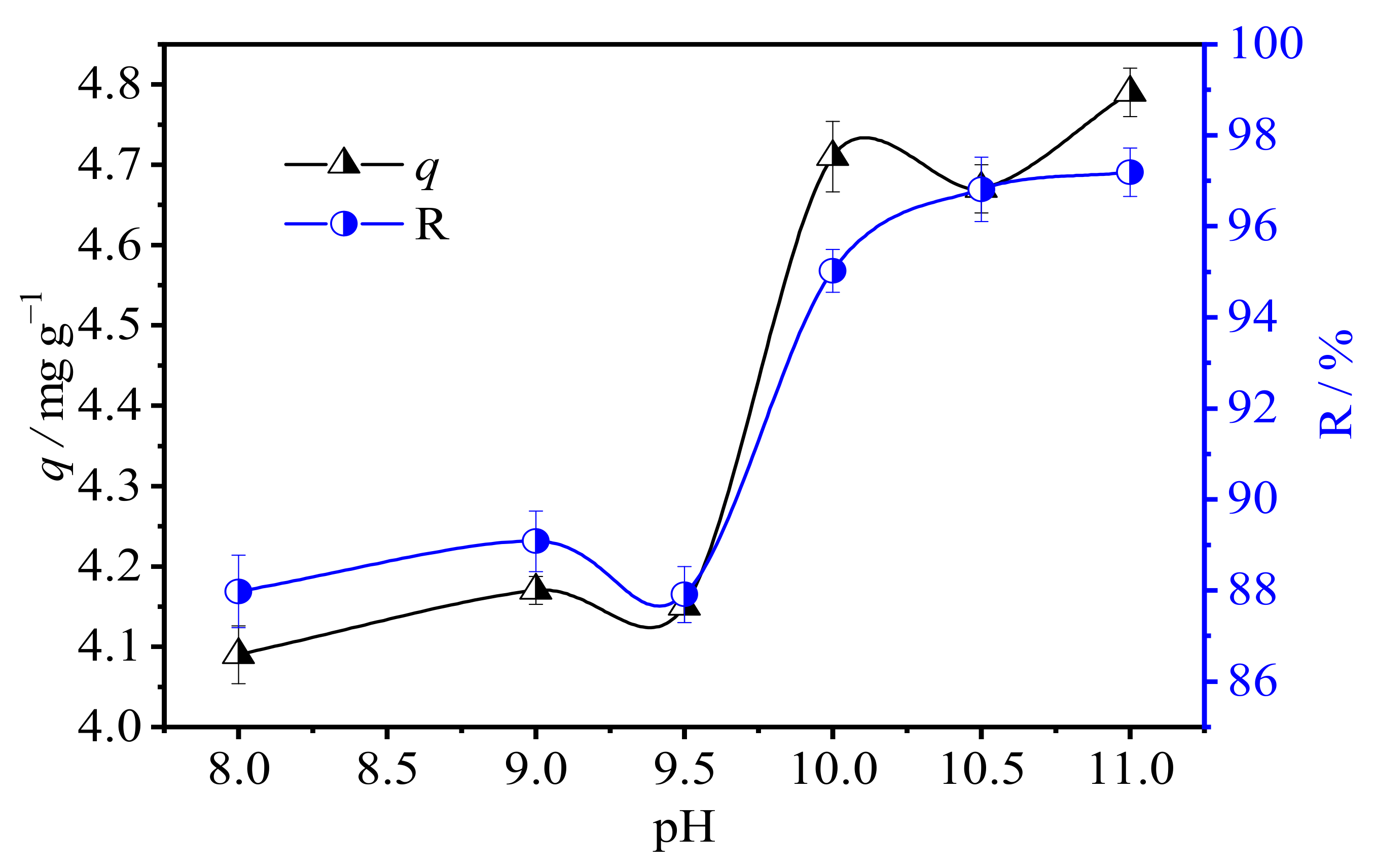
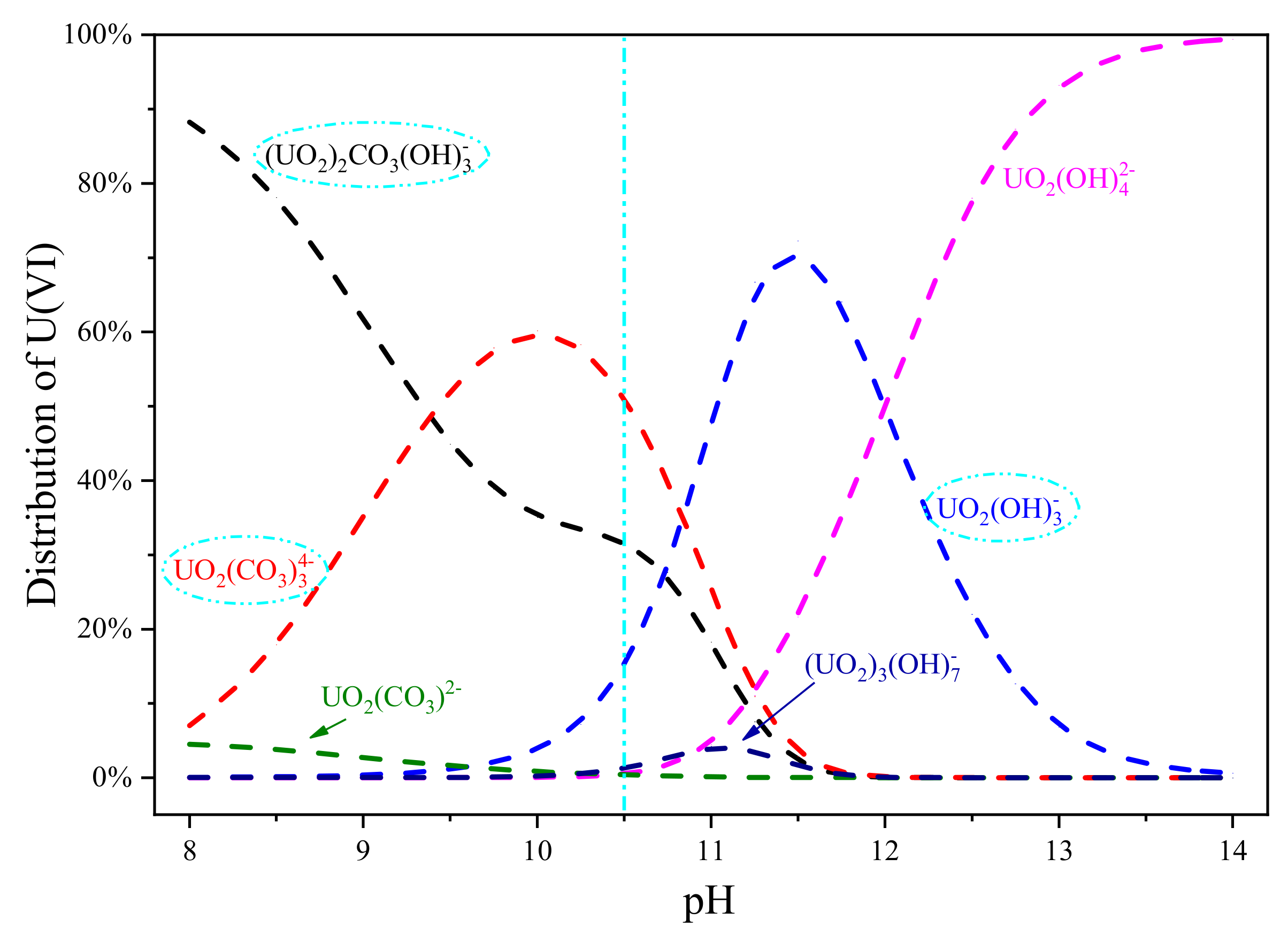

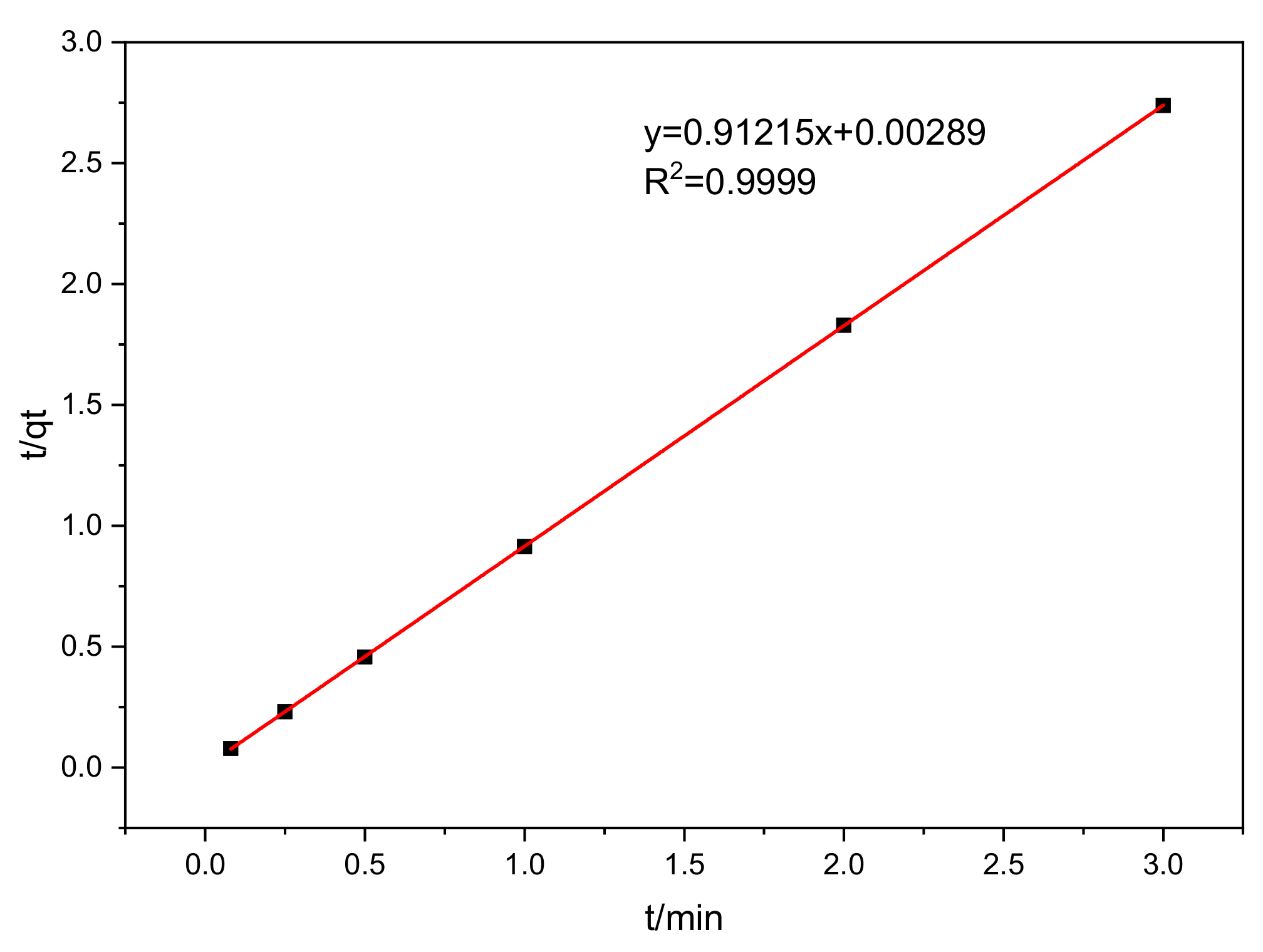
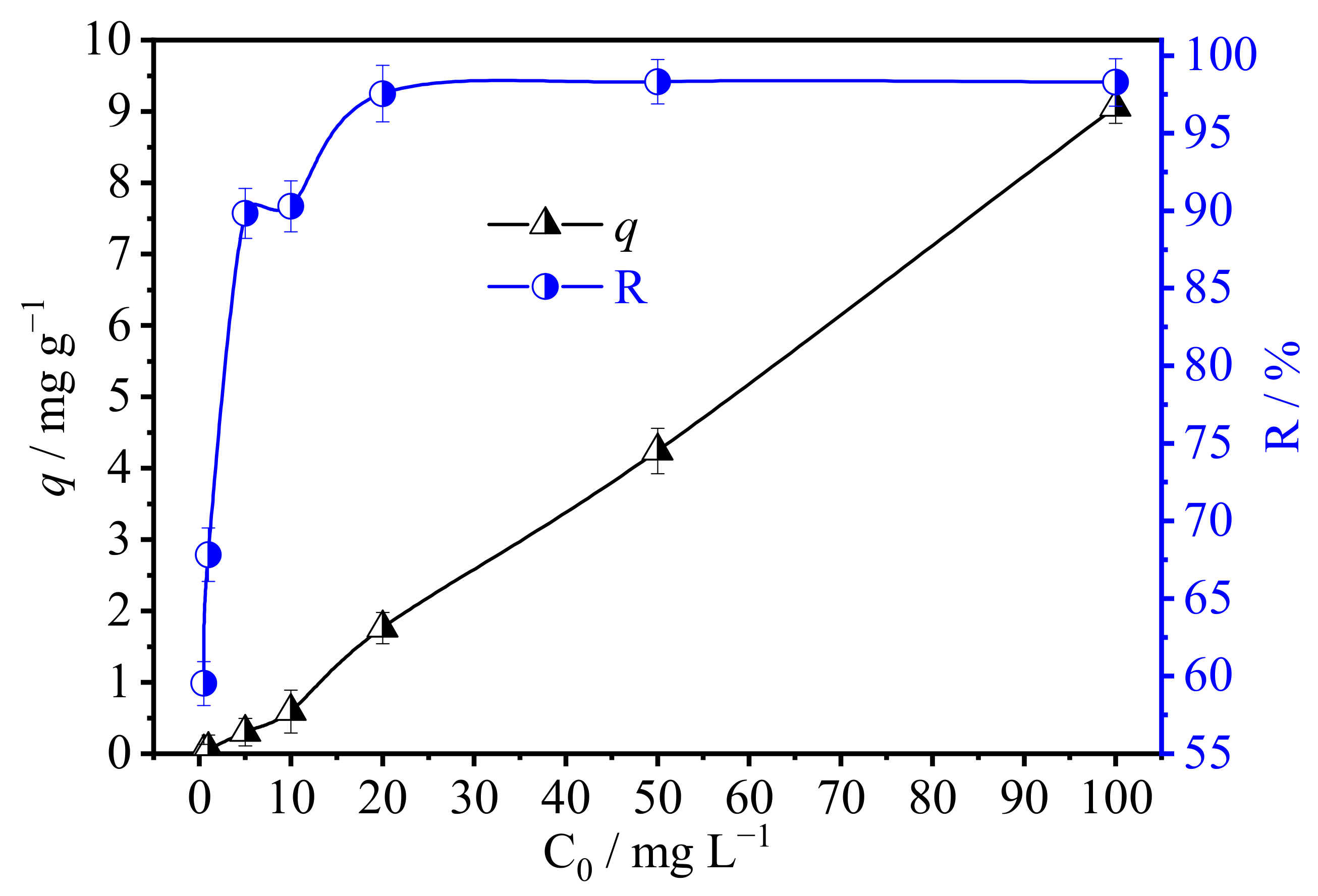
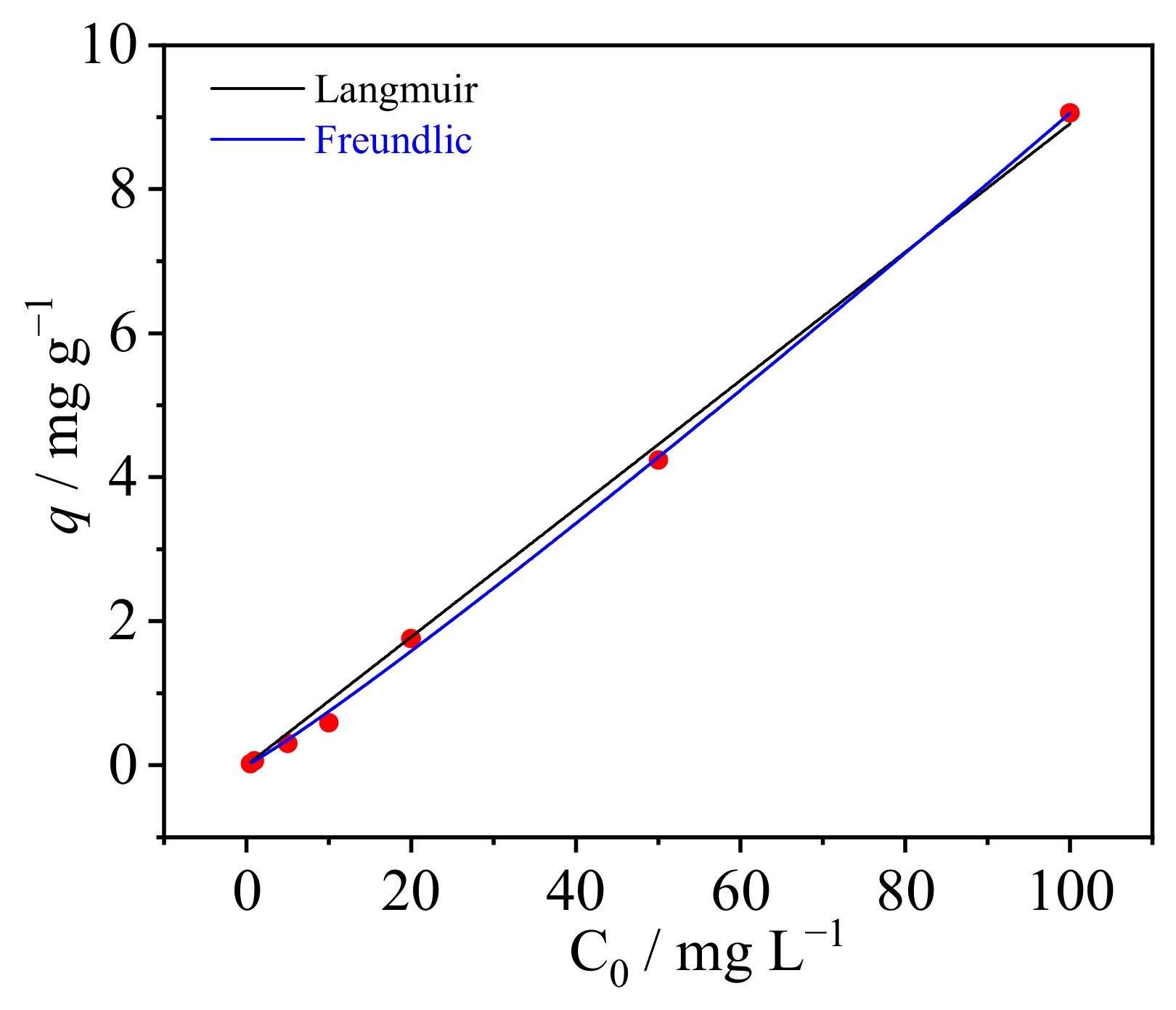
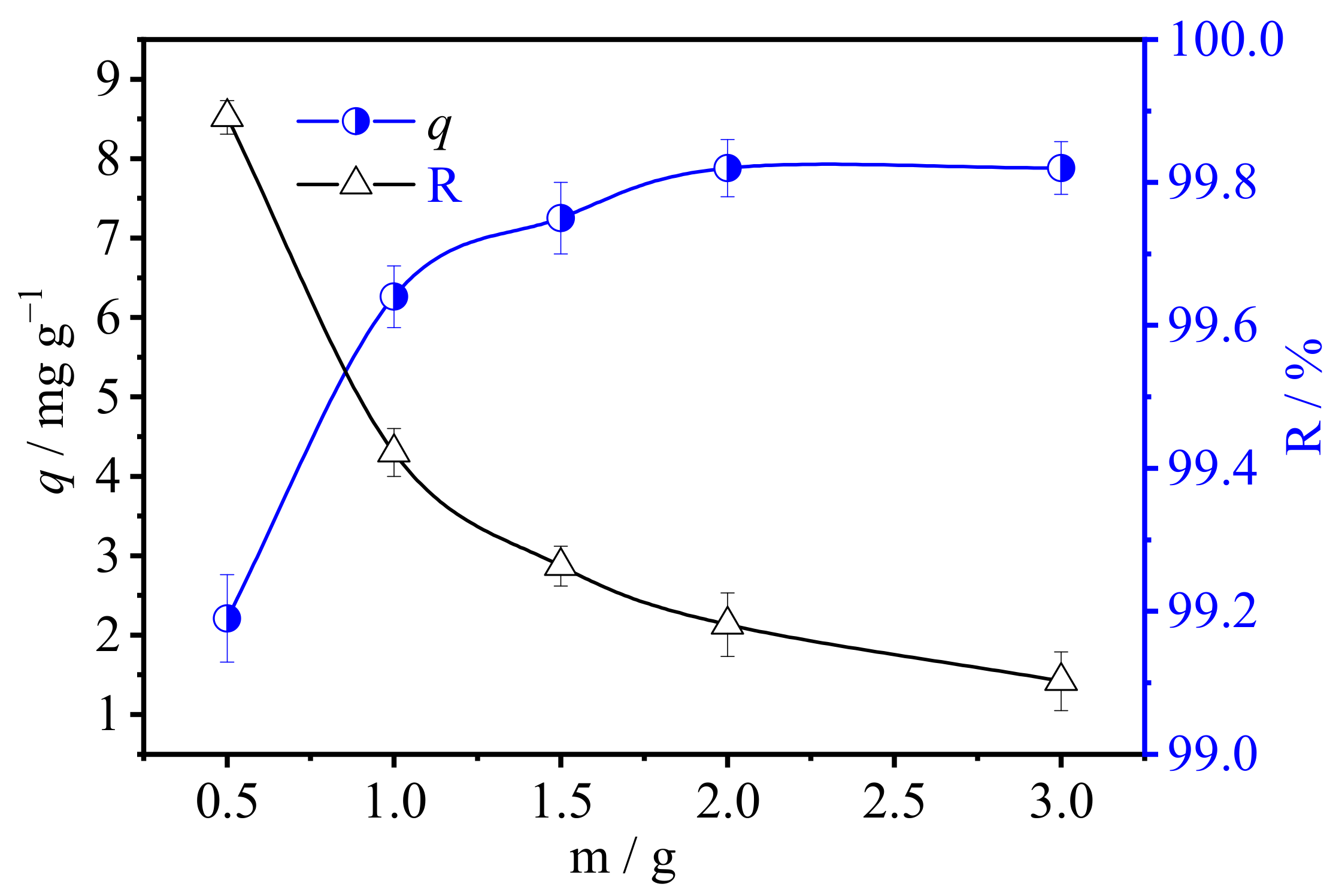
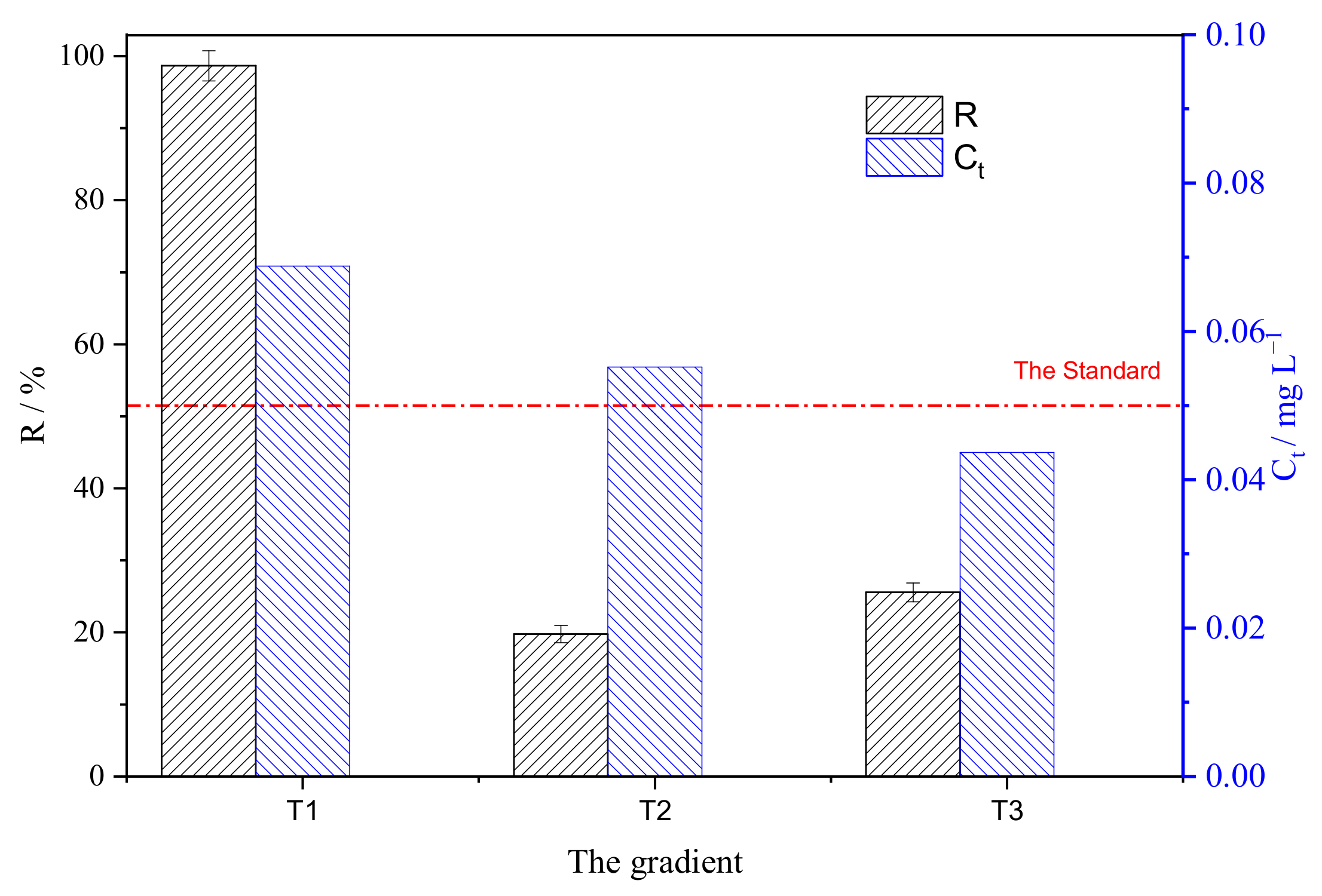
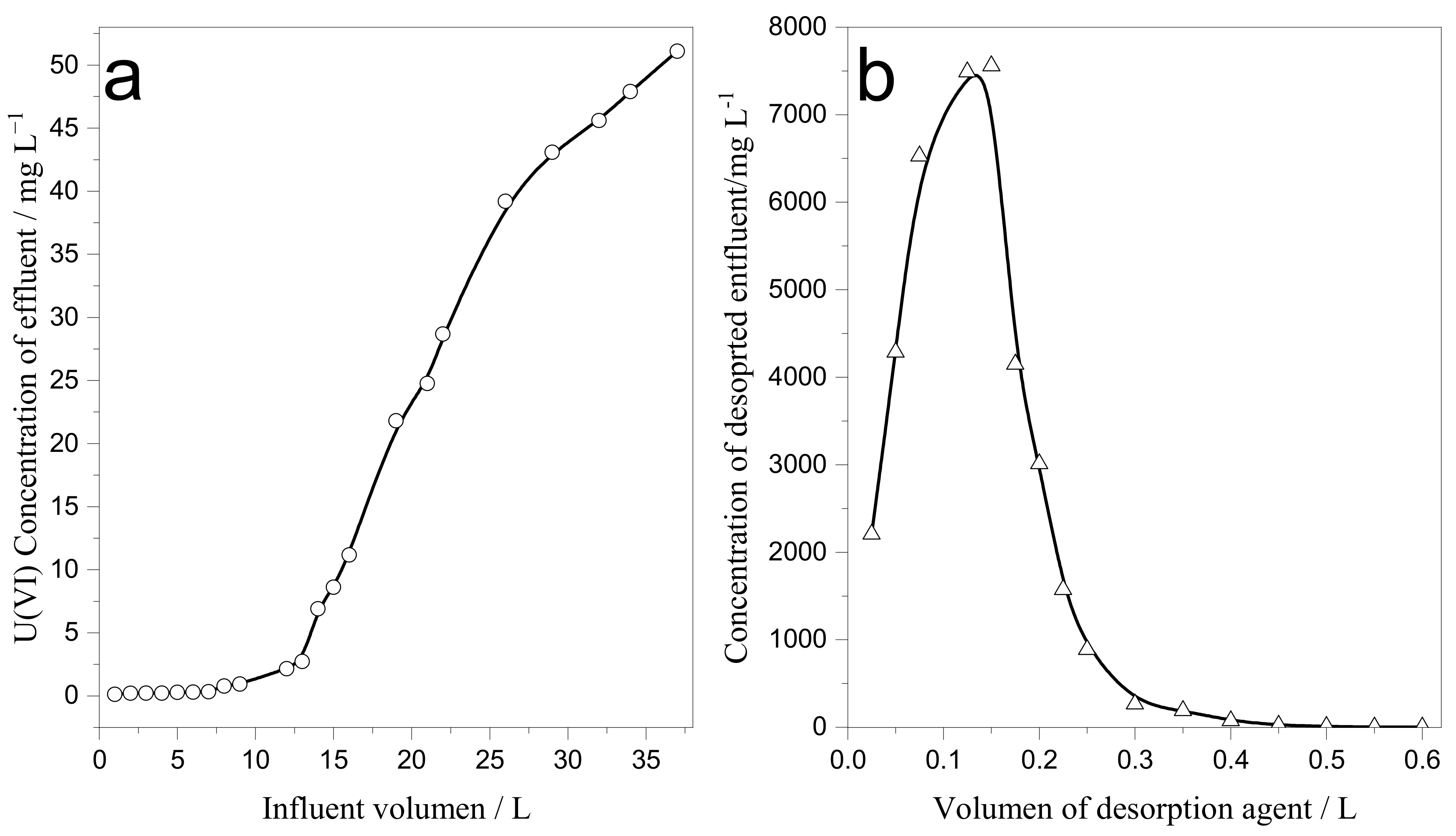
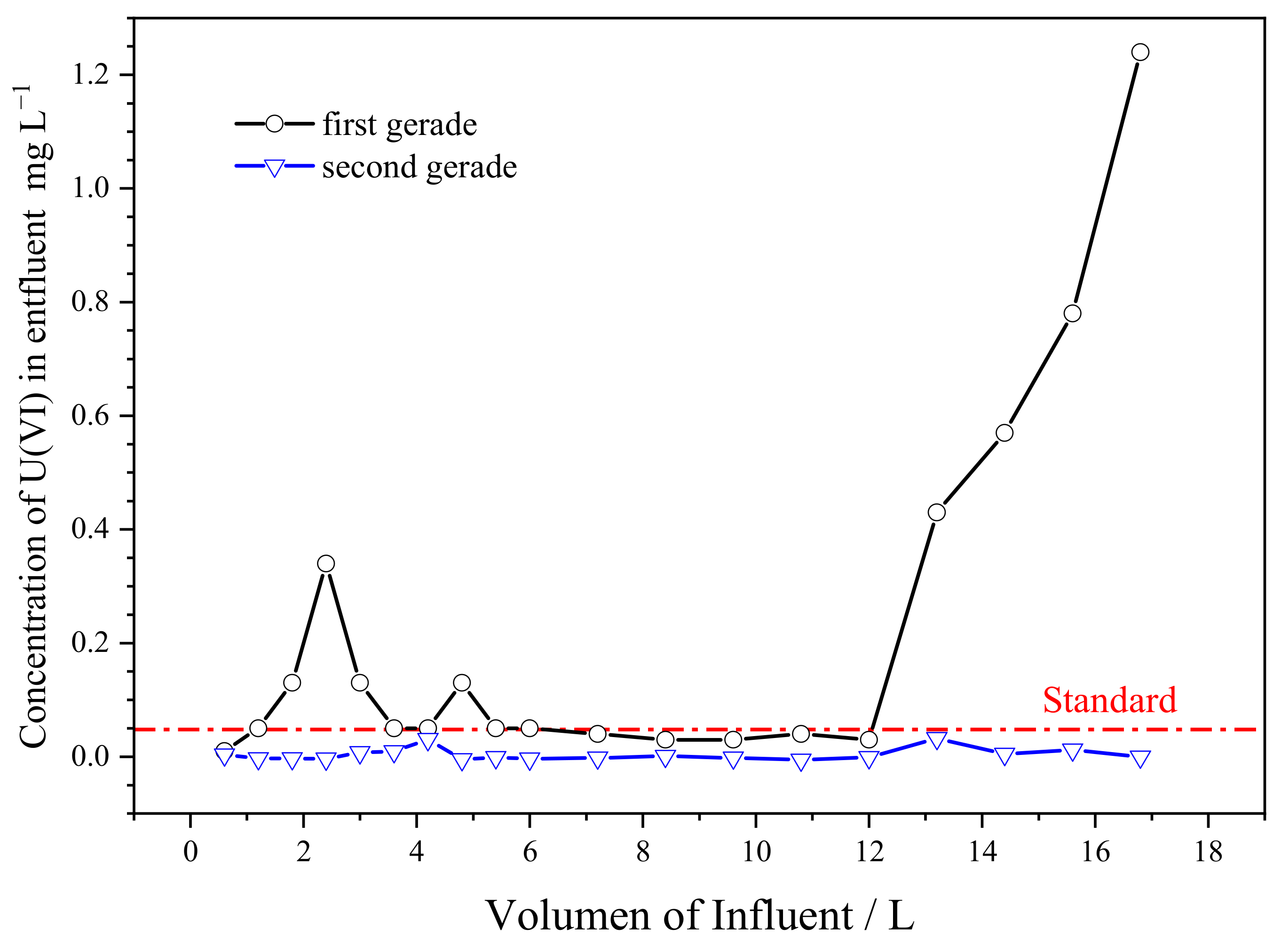
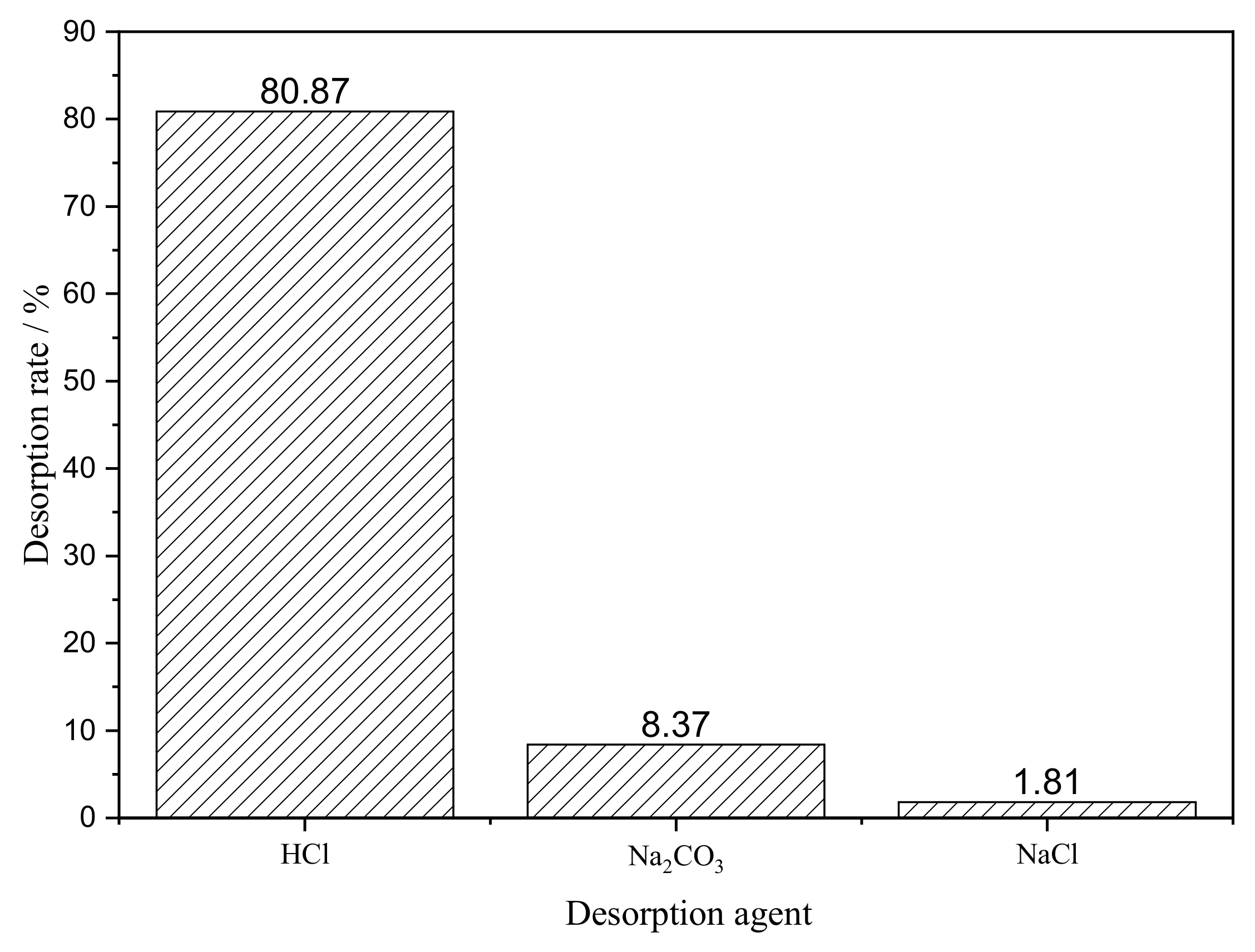
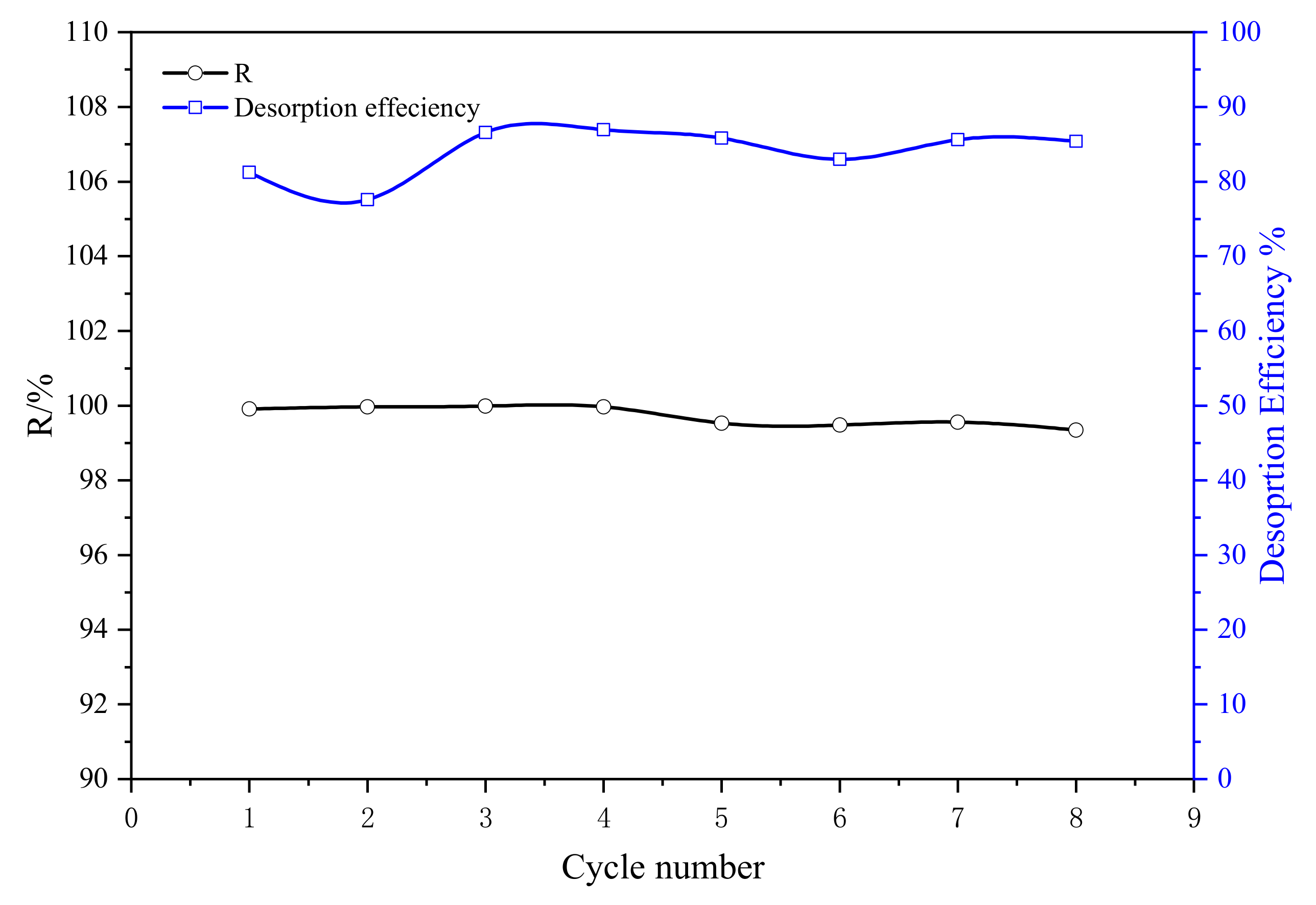
| K2 [g (mg·min)−1] | qe (mg g−1) | R2 |
|---|---|---|
| 287.9011 | 1.0963 | 0.9999 |
| n | Kf/(mg·g−1) | ka/(L·mg−1) | qm/(mg·g−1) | R2 | |
|---|---|---|---|---|---|
| Langmuir | 1.4738 | 0.0819 | 0.8496 | ||
| Freundlich | 2.7697 | 4.3647 | 0.8273 |
Disclaimer/Publisher’s Note: The statements, opinions and data contained in all publications are solely those of the individual author(s) and contributor(s) and not of MDPI and/or the editor(s). MDPI and/or the editor(s) disclaim responsibility for any injury to people or property resulting from any ideas, methods, instructions or products referred to in the content. |
© 2023 by the authors. Licensee MDPI, Basel, Switzerland. This article is an open access article distributed under the terms and conditions of the Creative Commons Attribution (CC BY) license (https://creativecommons.org/licenses/by/4.0/).
Share and Cite
Zhou, S.; Dong, F.; Qin, Y. High Efficiency Uranium(VI) Removal from Wastewater by Strong Alkaline Ion Exchange Fiber: Effect and Characteristic. Polymers 2023, 15, 279. https://doi.org/10.3390/polym15020279
Zhou S, Dong F, Qin Y. High Efficiency Uranium(VI) Removal from Wastewater by Strong Alkaline Ion Exchange Fiber: Effect and Characteristic. Polymers. 2023; 15(2):279. https://doi.org/10.3390/polym15020279
Chicago/Turabian StyleZhou, Shiping, Faqin Dong, and Yilin Qin. 2023. "High Efficiency Uranium(VI) Removal from Wastewater by Strong Alkaline Ion Exchange Fiber: Effect and Characteristic" Polymers 15, no. 2: 279. https://doi.org/10.3390/polym15020279
APA StyleZhou, S., Dong, F., & Qin, Y. (2023). High Efficiency Uranium(VI) Removal from Wastewater by Strong Alkaline Ion Exchange Fiber: Effect and Characteristic. Polymers, 15(2), 279. https://doi.org/10.3390/polym15020279







